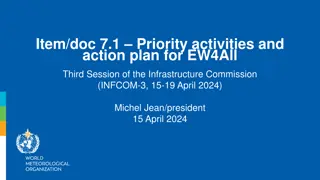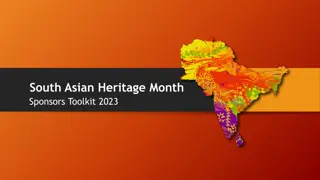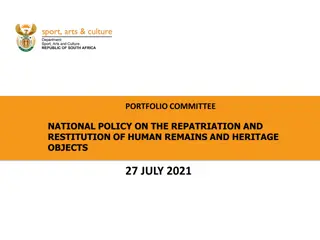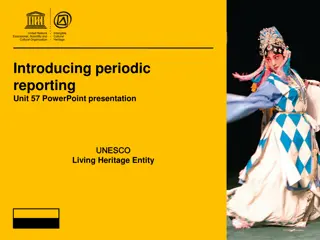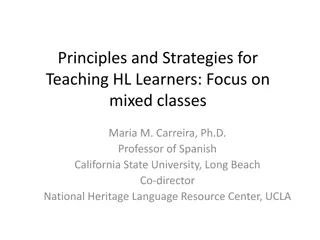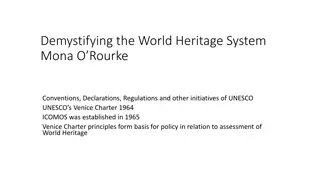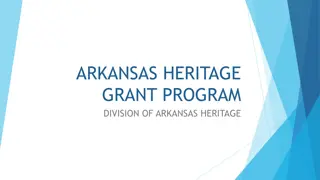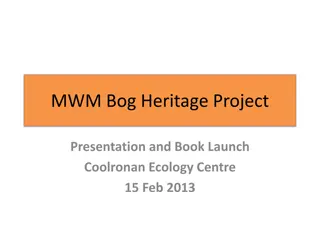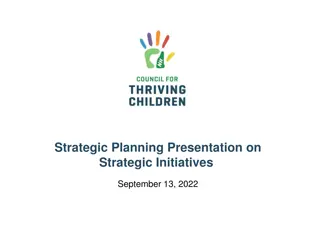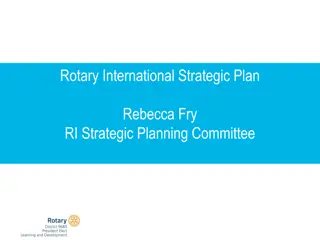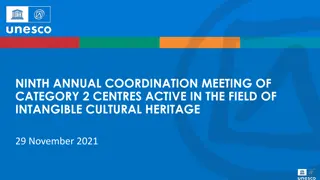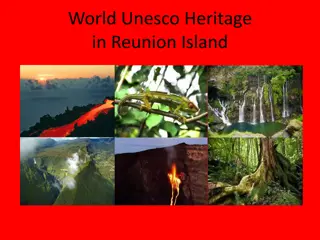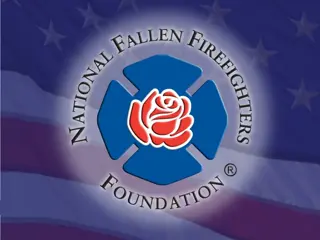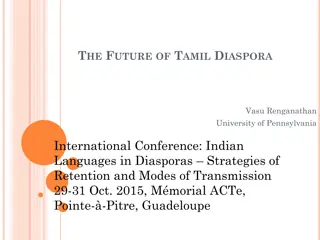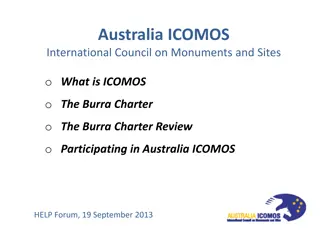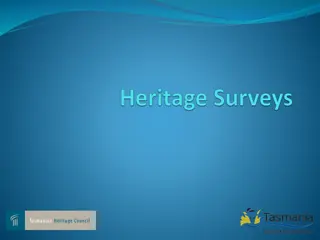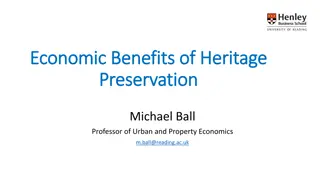World Heritage Process Fundamentals & Strategic Action Plan
Explore fundamental concepts in the World Heritage process, including baseline research, comparative analysis, and managing nominations. Learn about the Strategic Action Plan in place for effective implementation of the World Heritage Convention. Discover the vision for international cooperation and shared responsibility for conserving cultural and natural heritage.
Download Presentation

Please find below an Image/Link to download the presentation.
The content on the website is provided AS IS for your information and personal use only. It may not be sold, licensed, or shared on other websites without obtaining consent from the author. Download presentation by click this link. If you encounter any issues during the download, it is possible that the publisher has removed the file from their server.
E N D
Presentation Transcript
World Heritage Online Webinar Dept. of Culture, Heritage & the Gaeltacht in Partnership with ICOMOS Ireland 18th. June 2020 Grellan D. Rourke, Vice-President (Europe) ICOMOS International, Member of ICOMOS WH Evaluation Panel
Some Fundamental Concepts to consider in the World Heritage Process WH Convention Strategic Action Plan & Vision Baseline Research Comparative Analysis Boundaries & Buffer Zones Serial Nominations Transnational Serial Nominations Managing Serial Nominations Upstream & Midstream Processes Maintaining Momentum
World Heritage Convention (1972) Ratified by Ireland in 1991 Strategic Action Plan (-2022) for implementation of the WH Convention Vision Statement: International cooperation and shared responsibility through the WH Convention to ensure effective conservation of our common cultural and natural heritage nurtures respect and understanding among the world s communities and cultures and contributes to their sustainable development. identification of gaps (ICOMOS Gap Analysis 2004) preservation and enhancement of local cultural heritage in international context opportunities for increased capacities more effective communication engagement of communities sustainable development (2012+)
Baseline Research - Documentation need to have precise and comprehensive baseline information (it will include properties which may not make it into the nomination dossier) need this documentation to provide appropriate justification relative to the demonstration of OUV for the selected number and size of the component parts. need to have sufficient data and research to fulfil the requirements for global Comparative Analysis of the whole property. need to set up the information so that it can be used eventually for future needs, such as monitoring and Periodic Reporting.
Comparative Analysis Ascertains whether there is scope in the WH List for the inclusion of the nominated property. Demonstrates that there are no comparable properties in the same geo-cultural area with similar values that might be nominated in the future. If there are, a broader approach needs to be considered. Using an expert group to develop the CA is a preferred method. Have a clear methodology starting out. Starting point is to define what is the significance of the property and how this is manifested . The attributes and values must be clearly defined at the outset to find suitable comparators.
Comparative Analysis is a vital part of understanding and measuring the potential OUV. aim is not to demonstrate that the property is unique but that it has an exceptionally strong claim to be of Outstanding Universal Value. must draw conclusions and demonstrate where the property stands. It should be rigorous with a broad scope/it should be supported by best scientific information/ reference to relevant thematic studies. It must justify the selection of the components as well as demonstrate that the series as a whole is of potential OUV.
Where the Comparative Analysis sits Understand the attributes and values of the property and the World Heritage criteria that may apply to it Carry out a Global Comparative Analysis to test the values of the property against comparable World Heritage and other properties selected on a worldwide basis Confirm the criteria that should form part of the nomination and develop a Statement of Outstanding Universal Value UNESCO 2011. Preparing World Heritage Nominations. Second edition
Suggested sequence for preparing a nomination - UNESCO Background research Comparative analysis Draft Statement of OUV Define relevant attributes Assess authenticity and integrity Define appropriate boundaries Prepare description Complete history Complete dossier UNESCO 2011. Preparing World Heritage Nominations..
Comparative Analysis Not enough importance is given to this element; it needs to be addressed and integrated early in the process with consideration given when focusing on the Tentative List. It can often be a weak component of a nomination it is important to get this right. It can jeopardise the success of a nomination or at the very best delay it. Issues: lack of objectivity/not looking beyond same geo-cultural area/using only the WH and Tentative Lists/limiting comparison to less important properties/basing analysis on irrelevant attributes, etc.
Boundaries it is important to get it right Modifications to the boundaries later Minor modifications: Do not have a significant impact on the extent of the property nor affect its Outstanding Universal Value. Significant modifications extensions: The proposal shall be submitted as if it were a new nomination!
Boundaries Understanding the property leads to defining its boundaries and provides for effective protection. This is part of the evolution of the potential nomination and cannot be defined too early (flexibility). Preliminary assessment. Must be clearly defined in relation to legal protection and to management. OUV, Integrity, Authenticity, Protection and Management all influence the boundaries. Defining the boundaries is part of conflict management and prevention and requires stakeholder involvement. They need to be readily identifiable and tied to good up-to-date mapping.
Buffer Zones para 103-107 OG introduced 1997 Not part of the inscribed property but formally registered at time of nomination. Assist with protection, conservation and management and protect the overall setting. Added layer of protection. (Xi an Declaration, para 6, 2005) The Buffer Zone cannot be finalised until the Boundaries have been fully agreed. Creation/alteration of a Buffer Zone subsequent to inscription is normally considered a minor boundary modification. In exceptional circumstances a successful nomination may have no buffer zone The Forth Bridge/Madrid under evaluation (but legislation can change).
Serial Properties Serial nominations are an opportunity to reach a more balanced WH List and very much reflect the spirit of the World Heritage Convention There has been an increase in recent times and many are now inscribed or are in preparation Almost 30% of cultural World Heritage properties are serial properties (national, federal, transnational) The move to transnational (transboundary [OG]) is particularly challenging
Serial Properties They are a series of individual or discrete components which are not contained within a single boundary. Components may be quite close or geographically remote but all components are within a single country. Para 138: A serial nominated property may occur: a) on the territory of a single State Party - serial national property [Darmstadt] or b) within the territory of different States Parties, which need not be contiguous and is nominated with the consent of all States Parties concerned - serial transnational property (contiguous)/serial transnational property
Serial Properties there must be justification of a serial approach which is easily understood. each component part does not have to have OUV but should contribute to the OUV as a whole in a substantial readily defined way. the values, authenticity and integrity should determine the appropriate boundaries and the application of the serial approach. overall manageability is a consideration. may include intangible attributes (complex).
Serial Transnational Sites increasingly complex challenge involving -intergovernmental agreements -political issues -social issues -different legal frameworks -different administration frameworks
- long lead-in timeframe: Pre-historic pile-dwellings of the Alps inscribed in 2011 took about 20 years to prepare 6 SPs Champagne Hillsides, Houses & Cellars nomination (2015) took 10 years of intense work involving a vast number of stakeholders - administrative differences can lead to complications and need to be taken into account. Ensure level of compatibility or equivalence - achieving overall manageability and coherence of the property can be challenging - there can be a delicate balance of responsibilities - considerable cost implications (+ costlier evaluation missions)
But there are opportunities and benefits: -a tool for international co-operation -shared approaches leading to better management and conservation practices -exchange of technical and research information -development of integrated cultural tourism
Responsibility there is shared responsibility not just for the property but to each other. this has fundamental implications for management, conservation and danger listing. There must be oversight of the whole of the transnational property from a Joint Management Committee. responsibility needs to be apportioned clearly. a framework for conflict resolution should be in place.
Single Property Concept There is great pressure from both/all sides to share approaches from the outset and to ensure effective collaboration and commitment. Ideally serial transnational properties should be worked on together and submitted jointly in conformity with Article 11.3 of the Convention. If the values of one part of a serial (transnational) property are threatened, the entire property is threatened. There is joint responsibility at all levels. (pile dwellings - 6 SPs but it is one property)
Serial Transnational Sites flexibility Roman Limes/Frontier of the Roman Empire UK & Germany. There have been two extensions. Further extensions now being considered by additional SPs. Very delicate negotiation and extending the Joint Management Committee will be challenging. Vulnerability consideration. [Evolution] Silk Roads - multi-transboundary serial nomination with long-term plan China, Kazakhstan & Kyrgystan successful first nomination - a serial nomination may be submitted for evaluation over several nomination cycles provided that the first property has OUV in its own right - additions in the process to link across to Europe. [Planned]
Resources Large complex serial nominations demand considerable resources from SPs/Others, sometimes over a considerable number of years. Funding needs to come at the right time and not too soon in terms on onsite investment so as not to undermine the OUV or jeopardise the nomination. Long-term benefits delivered against the cost of investment in resources need to be measured in a holistic way. Once the nomination has been successful there will be a requirement for ongoing resources to be made available. How will bilateral collaboration be achieved? Formal structures need to be put in place to ensure financial sustainability. (issue)
Management of Serial Properties The management of serial properties is particularly onerous. They cannot be managed in the same way as single properties but require a more complex and integrated approach. Management must be constructed from the top down an overall framework down to detailed management of each component. The activities and responsibilities at the different levels of the management system must be defined. The decision-making processes need to be clearly set out. There should be a common vision for the conservation and sustainable development of the property and a common understanding and commitment to the management system.
Management of Serial Properties Having a system in place for ensuring the co-ordinated management of the separate components is essential and this should be documented in the nomination. The management system must have effective arrangements for bilateral/ multilateral collaboration for the joint control, protection, management and monitoring of the state of conservation of the components forming the serial property. The values for which the properties were inscribed must be maintained over time and the management system must ensure this.
Effective Management must be able to deliver effective protection must identify threats affecting OUV (Risk Assessment) must prioritise issues to inform management strategies must ensure inter- and multi-disciplinary involvement should have clearly set out goals which are measurable should define responsibilities and decision-making processes should embrace respect for local traditions should be seen as a work in progress with regular review
Upstream Process Initiated in 2010 to deal with some challenging nominations. Now integrated into the Operational Guidelines (paras 71 &122), its aim is to reduce significant problems. Advisory Bodies provide advanced support directly to States Parties prior to the preparation or submission of a nomination. No formal guidelines as yet in preparation. Financed directly by: the State Party itself or application to the World Heritage Fund. Ideally it should be considered during the development of the Tentative List or early in the process of nomination. UNESCO deadline for requests (17th. April 2020) request format.
Midstream Process There is an informal mid-stream process (negotiation with Advisory Bodies). The Architectural Work of Le Corbusier, an Outstanding Contribution to the Modern Movement - twice failed and withdrawn - late mid-stream advice was given from the ISC 20th. Century - on third occasion the SPs (7) submitted one of the best nomination dossiers ever. Viking Heritage multi-transboundary - first dossier withdrawn as not yet ready & major sites missing - no overall plan - under re-appraisal and mid-stream advice.
Maintaining Momentum Working towards getting on the Tentative List and ultimately working on the nomination dossier is a slow and daunting process. Clearly there is a need to gather experts together to ensure the process advances and developing a staged approach could provide a useful methodology and might make it easier to achieve the ultimate goals. Over a long period, setting up a series of conferences, exhibitions, lectures, seminars and workshops - depending on the subject - could deal with the many aspects of information-gathering, assessment, discussion and evaluation. These could be stand alone events initially which might make it easier to attract funding. All the time the outcomes would be feeding the eventual nomination dossier. A series of publications (online) could also be considered, based on aspects of the nomination.
Good Guidance there are a wide range of up-to-date publications available to inform and guide. See ICOMOS bibliography. there are nomination dossiers in place for serial sites which could act as useful models. there are systems in place for the management of existing serial nominations and these should be examined and evaluated, particularly as to their efficacy.







